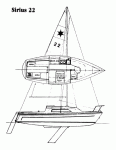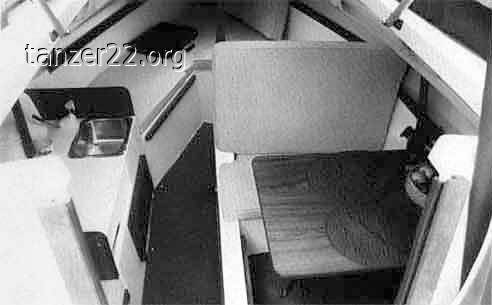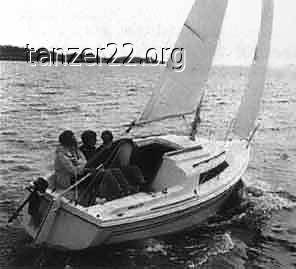
The Sirius 22 is a new model but not really a new design. More than 600
Sirius 21s were sailing before the builder, Vandestadt & McGruer, decided
to reverse its plumb transom and create the "new" 22.
Although the Sirius is available with a fixed fin keel, we sailed the more
easily trailered swing-keel version. Those intent on trailering the Sirius
will appreciate having a keel that fits close to the bottom, but the
trade-off is a keel trunk that forms a narrow ridge down the center of the
main cabin. It reduces valuable sole space, requires close attention to
footing when using the companionway in a sea, and makes entry into the
dinette difficult for anyone with feet bigger than size 10. (The fin-keel
version of the Sirius has a flush sole.)
The table seats two comfortably enough while at anchor, but the berth into
which it converts is too short for an average adult. Two tall crewmembers
could sleep peacefully in the unusually long vee-berth forward, and a
six-footer could easily bed down in the port quarter berth, though it often
seems that this space is used as an all-purpose storage area in most boats.
The builder's brochure states that the Sirius "accommodates five
adults." We don't agree, but then we don't know any 22-foot trailerable
sailboat that does house five with any degree of civility.
Interior trim is mostly of the "screw-in-place" variety now the norm in
boats of this level. It's effectively executed and gives a clean
appearance. The cabin sole is covered with synthetic carpet. It fits neatly
and "shows well," but we think wood soles live more comfortably in the
real world of sand and saltwater. The poptop companionway hatch cover is
well worked out and provides a place below to stand upright. With the
optional "windowed" cover, the boat tents in nicely on rainy days.
Sirius' cockpit is filled with friendly angles and well-rounded corners.
The backrests are sufficiently deep to provide some support. This is a
self-bailing cockpit you sit in, not on, but we found that its limit for
comfortable sailing is three crew. Additional seating can be found on deck.
The tall house also provides a good perch away from the crowd and holds the
teak grab rails at a usable height. Going forward, you'll find narrow
sidedecks but several good handholds help make the trip easier. We were
pleased to see a substantial vinyl rubrail protecting the perimeter of the
hull, and an anchor locker for the foredeck. Steinmetz would have preferred
larger mooring cleats than the four 6-inch aluminum cleats, the size found
on most of the Sea Trials boats.
The Sirius' hull laminate consists of chopped strand, mat, and 18/10
stitch mat (a fabric made of woven roving sewn to mat). Additional layers
are added to the bottom and still more are placed near the keel trunk.
There is plenty of glass here -- this is a strong hull. For the deck, the
same 18/10 fabric is used along with chop and Coremat. In lieu of the usual
plywood backing plates, additional roving is placed under deck hardware.
According to the manufacturer, this is a stronger system, in which dry rot
or delamination won't be a worry. Even in areas not visible to the casual
observer, the fiberglass work is handled with care.
Given the careful glasswork, we were surprised to see some cheap-looking
fittings on the interior. For instance, the forward hatch is secured with a
narrow gauge bolt and wing nut. Not only could the wing nut come off the
bolt, but the sharp-ended bolt itself hangs down like a treacherous
stalactite from the cabin ceiling.
To Vandestadt & McGruer's credit, 30 cubic feet of polyurethane foam are
poured between the liner and the hull bottom and under the berths and
seats. We believe that all boats of this type should be equipped with
positive flotation. Because their displacements are modest, not much foam
is needed; and as they're seldom called upon for extended cruising, the
lost locker space is tolerable. Steinmetz was concerned that the foam’s
location low in the boat could cause stability problems when the boat is
flooded. Sirius' manufacturer assured him that the little cruiser should
remain upright provided the keel is locked in its down position, but he
admitted that the boat had never been swamped for test purposes.
The Sirius is a spirited sailer and responded well to its light helm. All
the standard sail control hardware -- winches, boom yang, genoa tracks and
cars -- allowed us to bring the boat up to speed, but the ambience of the
moment was spoiled by a loud and persistent hum from the keel cable. The
annoying noise defied the best efforts of a factory representative to
effect a cure. During his furious grindings on the keel winch, located in
the cabin below the companionway, he explained that singing keel cables are
not a problem common to these boats. We are glad to report nothing broke.
At least this experience demonstrated the easy operation of the system.
Still, manipulating the heavy keel is a slow process — you have to pay
something for all that mechanical advantage. As you might expect, the
little Sirius shows the effect of 525 pounds of cast iron being winched up
into its truck by becoming noticeably less stable. In most conditions,
the boat should be sailed with the keel down and locked.




